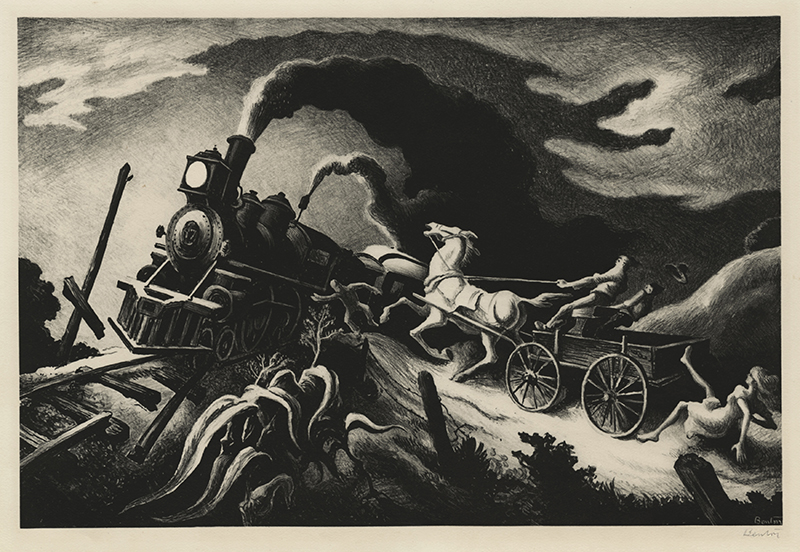Wreck of the Ol’ 97 is a lithograph from 1944 created by the American regionalist, Thomas Hart Benton. It is pencil signed and was published by Associated American Artists in an edition of unknown size. The references for this work are AAA 585 and Fath 63. Wreck of the Ol’ 97 was printed by George Miller on a cream wove paper that bears a partial watermark. The image measures 10-3/8 x 14-15/16 inches.
This lithograph is based upon the painting, Wreck of the Ole '97. Based upon a ballad of the same title, the image depicts a steam locomotive speeding to make up time. The locomotive was on a three-mile grade when the engineer lost his air breaks causing the train to jump the tracks and descend down a Virginia mountain.
Thomas Hart Benton, painter, muralist, and printmaker, was born on 15 April 1889 in Neosho, Missouri. He was named after his great grandfather, Thomas Hart Benton, who was a five-term senator. His father, Maecenus Benton, was a lawyer and United States representative so, in his formative years, the young Benton spent time in Washington, D.C. and southern Missouri. He dropped out of school at seventeen years old to work as a cartoonist for the Joplin American newspaper but his father enrolled him in the Western Military Academy in Illinois in 1906 before consenting to allow him to enter the School of the Art Institute of Chicago the following year. In 1908, Benton studied at the Académie Julian where he met the American modernist artist Stanton Macdonald-Wright and came under his influence. He explored Macdonald-Wright’s synchromistic style of abstract painting and Benton’s paintings from as late as the mid 1920s often exhibit this influence.
Benton returned to the U.S. in 1911 settling in New York. During the First World War he created illustrations for a catalogue of ships and military equipment while stationed at the naval base in Norfolk, Virginia. After the war, Benton went back to New York and became an influential teacher at the Art Students League. Due to the illness of his father, he headed back to Missouri to visit but settled permanently in Kansas City, Missouri in 1935. By this time, he had completely broken away from modernism and his style was naturalistic and greatly influenced by the Spanish painter El Greco. Benton painted a number of monumental murals in the 1930s including mural cycles for the New School of Social Research, the Whitney Museum of American Art, the New Britain Museum of American Art, and the 1933 Chicago Worlds Fair, and in the process became known as one of the most innovative mural painters in America. His politics were leftist leaning and his imagery depicted the working class in rural America and his painting and murals were often social commentaries on injustices. Benton was among the three leading regionalist painters, which also included Grant Wood and John Steuart Curry. In Kansas City, he taught at the Art Institute until 1941 and, in 1936, he completed a mural for the Missouri State Capitol.
After World War II, regionalism fell from favor but Benton’s work is still celebrated and exhibited, and is represented in the collections of the Crystal Bridges Museum of American Art, Bentonville, Arkansas; the Art Institute of Chicago; the Kemper Museum of Contemporary Art and the Nelson-Atkins Museum of Art, Kansas City, Missouri; the Metropolitan Museum of Art and the Whitney Museum of American Art, New York; the Fine Arts Museums of San Francisco; the National Gallery of Art and the Smithsonian American Art Museum, Washington, D.C.
Thomas Hart Benton died on 19 January 1975 in Kansas City, just after putting the finishing touches on a mural for the Country Music Hall of Fame in Nashville, Tennessee.
source: The National Gallery of Art



